‘Bad King John’ Of England: His Lost Treasures Have Never Been Found
A. Sutherland - AncientPages.com - The legend of King John's lost treasure has been handed down from generation to generation.
However, it is not only a legend.
John was King of England from 1199–1216. He proved to be a total failure as a ruler. Between 1202 and 1204, the King of France managed to capture most of the lands in France held by John. Afterward, John was given the nickname 'soft sword.'
He acted King from 1189 when his brother Richard the Lion-Heart was on the Third Crusade.
'Lackland' was John's other nickname, most probably because, as the youngest of Henry II's five sons, it was challenging to find a portion of his father's French possessions for him to inherit.
Involved in intrigues against his absent brother, John eventually became King in 1199 when Richard the Lionheart was killed in battle in France. After that, he was portrayed as 'Bad King John.'
Ancient sources say that John ruled like a tyrant. To pay for the war with France, he raised taxes – imposing a special tax on Jews – and enforced feudal prerogatives. He was accused of extorting money from people and selling offices.
King John's Tomb, Worcester Cathedral Set before the high altar, his tomb is made of dark Purbeck marble topped with an effigy. When King John lay dying of his famous "surfeit of peaches" in 1216, he asked to be buried in Worcester Cathedral. Image credit: Bob Embleton - CC BY-SA 2.0
'Bad King John' had a great hobby: collecting jewelry. He was particularly fond of collecting (stealing) jewelry for himself and coinage for his guards and soldiers. He owned a hoard of gold and silver plates and other valuables, of which the most valuable were the imperial regalia he had inherited from his grandmother, the Empress of Germany.
On 12 October 1216, John lost all of his treasure when he tried to take a shortcut across a stretch of water in Wash, the large bay that separates East Anglia from Lincolnshire.
This particular region of marshes and mudflats was usually traversable at low tide but not otherwise. The tide rose faster than the King expected. He misjudged the power of the wave, leading to the advancing waters claiming his precious baggage train. John's baggage, which supposedly included all royal treasures, including the Crown Jewels and gold coins, was engulfed in a raging whirlpool.
King John of England, 1167-1216 on hunt. Public Domain
'Bad King John' lost everything. He died only a few days later, on 18 October 1216, at Newark.
What happened to John's treasure carts? Is John's treasure buried somewhere in the area of Sutton Bridge? Treasure hunters from the USA and England have attempted to locate the exact location of the incident. Even a team of researchers from Nottingham University took soil samples to shed some light on the incident in 1216.
The search goes on because, as you know, treasure hunters never lose hope of finding what they are looking for.
Written by – A. Sutherland - AncientPages.com Senior Staff Writer
Updated on March 27, 2024
Copyright © AncientPages.com All rights reserved. This material may not be published, broadcast, rewritten or redistributed in whole or part without the express written permission of AncientPages.com
Expand for referencesReferences:
T. Carte, A General History of England
Ralph V Turner, King John: England's Evil King?
More From Ancient Pages
-
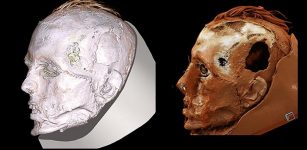 Never-Before-Seen Face Of A Tattooed Tashtyk Man Hidden Behind A Gypsum Death Mask Revealed
Archaeology | Jul 17, 2020
Never-Before-Seen Face Of A Tattooed Tashtyk Man Hidden Behind A Gypsum Death Mask Revealed
Archaeology | Jul 17, 2020 -
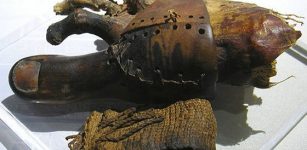 3,000-Year-Old Egyptian Artificial Wooden Toe In New Light
Archaeology | Jun 20, 2017
3,000-Year-Old Egyptian Artificial Wooden Toe In New Light
Archaeology | Jun 20, 2017 -
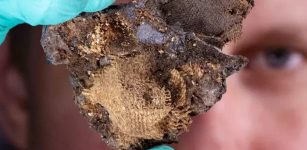 Little-Known Mummy Fragments Analyzed By Scientists
Archaeology | Jan 3, 2024
Little-Known Mummy Fragments Analyzed By Scientists
Archaeology | Jan 3, 2024 -
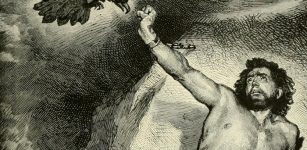 Prometheus ‘Fire Bringer’ – Hero Stealing Fire From Gods Giving It To Mortals
Featured Stories | Sep 5, 2018
Prometheus ‘Fire Bringer’ – Hero Stealing Fire From Gods Giving It To Mortals
Featured Stories | Sep 5, 2018 -
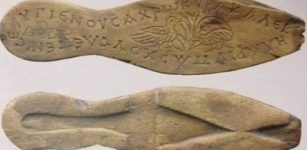 Byzantine Sandals With A Nice Message Found In The Harbor Of Eleutherios (Theodosius) – Now On Display
Artifacts | Apr 12, 2023
Byzantine Sandals With A Nice Message Found In The Harbor Of Eleutherios (Theodosius) – Now On Display
Artifacts | Apr 12, 2023 -
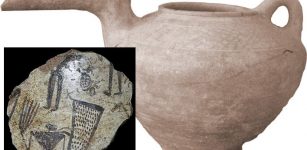 7,000-Year-Old Tepe Ozbaki Mounds Yielded Valuable Relics – But Now The Site Is In Trouble
Archaeology | Nov 25, 2020
7,000-Year-Old Tepe Ozbaki Mounds Yielded Valuable Relics – But Now The Site Is In Trouble
Archaeology | Nov 25, 2020 -
 Gigantic Unfinished Stone Structures Cut With Amazing Stone-Working Techniques
Civilizations | Sep 21, 2015
Gigantic Unfinished Stone Structures Cut With Amazing Stone-Working Techniques
Civilizations | Sep 21, 2015 -
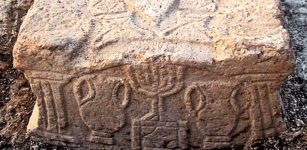 Rare 2nd Temple-Era Etchings Of Menorah And Cross Discovered In The Judean Hills
Archaeology | Jan 8, 2017
Rare 2nd Temple-Era Etchings Of Menorah And Cross Discovered In The Judean Hills
Archaeology | Jan 8, 2017 -
 Mystery Of The Ancient Unknown Mining Civilization In North America – Puzzling Archaeological Discoveries – Part 1
Civilizations | Apr 18, 2022
Mystery Of The Ancient Unknown Mining Civilization In North America – Puzzling Archaeological Discoveries – Part 1
Civilizations | Apr 18, 2022 -
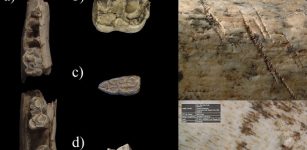 Neanderthal Hunting Camp Discovered In The Center Of The Iberian Peninsula
Archaeology | Aug 30, 2021
Neanderthal Hunting Camp Discovered In The Center Of The Iberian Peninsula
Archaeology | Aug 30, 2021 -
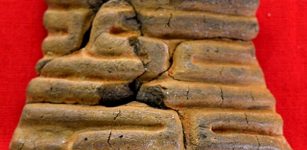 3,000-Year-Old Piece Of Pottery Unearthed On Okinawa Island, Japan
Archaeology | Feb 21, 2017
3,000-Year-Old Piece Of Pottery Unearthed On Okinawa Island, Japan
Archaeology | Feb 21, 2017 -
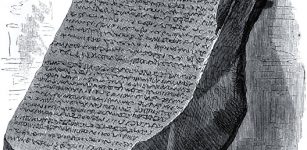 Rosetta Stone – Artifact That Solves The Riddle Of Egyptian Hieroglyphics
Artifacts | Sep 28, 2015
Rosetta Stone – Artifact That Solves The Riddle Of Egyptian Hieroglyphics
Artifacts | Sep 28, 2015 -
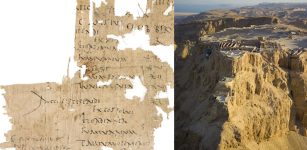 Rare Ancient Paycheck Of A Roman Legionary Soldier Found At Masada
Archaeology | Feb 16, 2023
Rare Ancient Paycheck Of A Roman Legionary Soldier Found At Masada
Archaeology | Feb 16, 2023 -
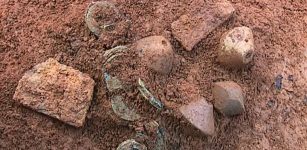 2,000-years-old tomb found in S. China
Archaeology | Apr 6, 2016
2,000-years-old tomb found in S. China
Archaeology | Apr 6, 2016 -
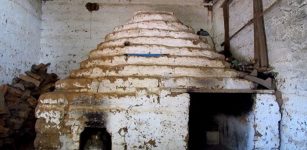 Ancient Mayans Used Saunas For Healing Purposes
Ancient History Facts | May 12, 2016
Ancient Mayans Used Saunas For Healing Purposes
Ancient History Facts | May 12, 2016 -
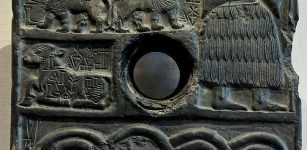 Babylonian Story Of Bird-God Anzu ‘The Wise One’ And His Underworld Realm
Featured Stories | Dec 10, 2016
Babylonian Story Of Bird-God Anzu ‘The Wise One’ And His Underworld Realm
Featured Stories | Dec 10, 2016 -
 400-Year-Old Shipwreck Found Off The Coast Of Portugal Labeled ‘Discovery Of A Decade’
Archaeology | Sep 26, 2018
400-Year-Old Shipwreck Found Off The Coast Of Portugal Labeled ‘Discovery Of A Decade’
Archaeology | Sep 26, 2018 -
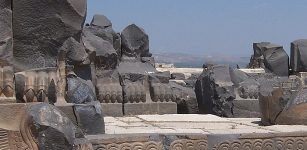 Unsolved Mystery Of The Giant Footprints Outside The Ain Dara Temple
Featured Stories | Jun 7, 2014
Unsolved Mystery Of The Giant Footprints Outside The Ain Dara Temple
Featured Stories | Jun 7, 2014 -
 Political Debates In Ancient Rome: Great Harshness, Personal Attacks And Unpleasant Atmosphere
Archaeology | Aug 29, 2018
Political Debates In Ancient Rome: Great Harshness, Personal Attacks And Unpleasant Atmosphere
Archaeology | Aug 29, 2018 -
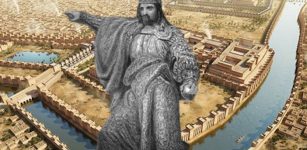 Babylon’s Kiln-Fired Bricks Almost Erased The City From History
Featured Stories | Dec 13, 2018
Babylon’s Kiln-Fired Bricks Almost Erased The City From History
Featured Stories | Dec 13, 2018



